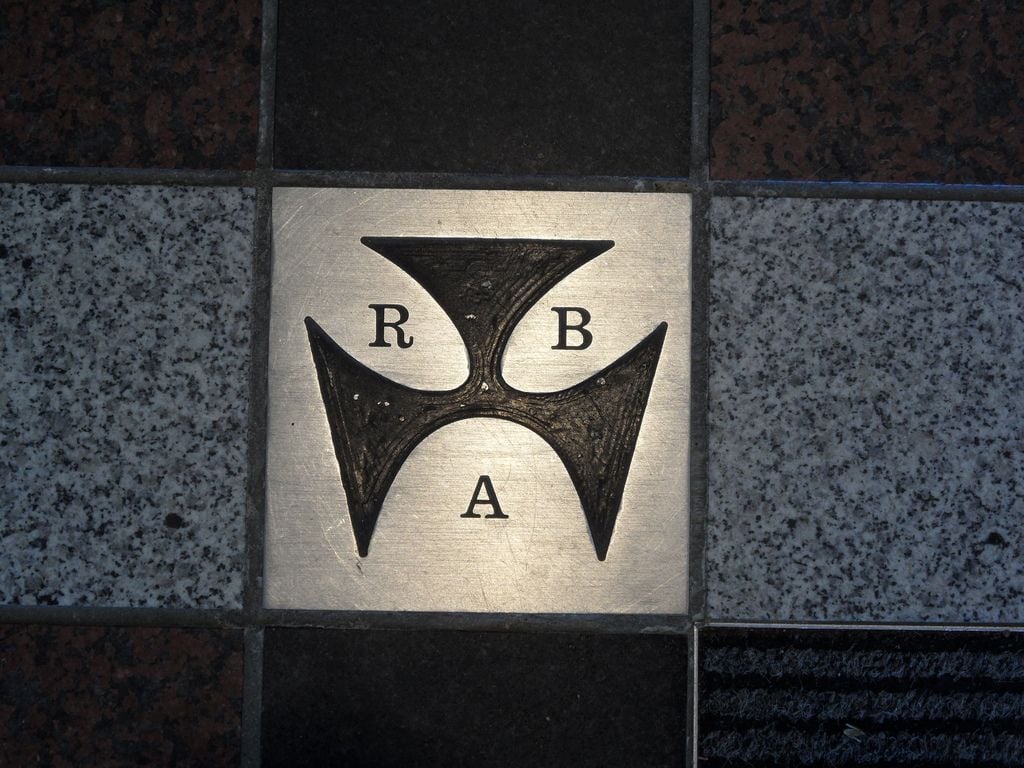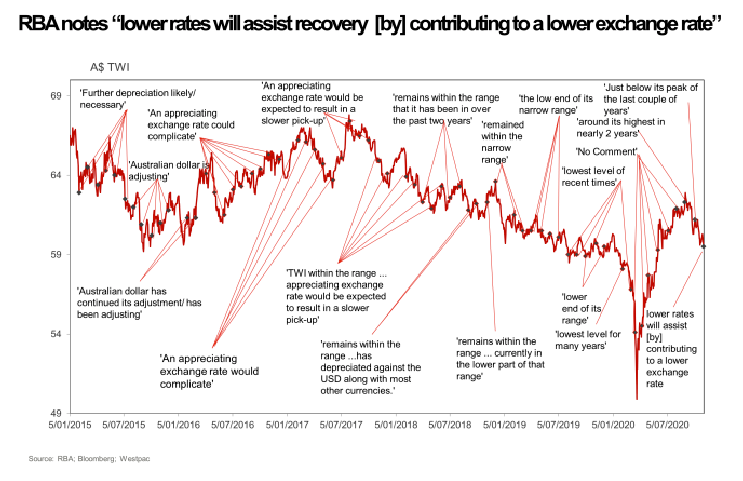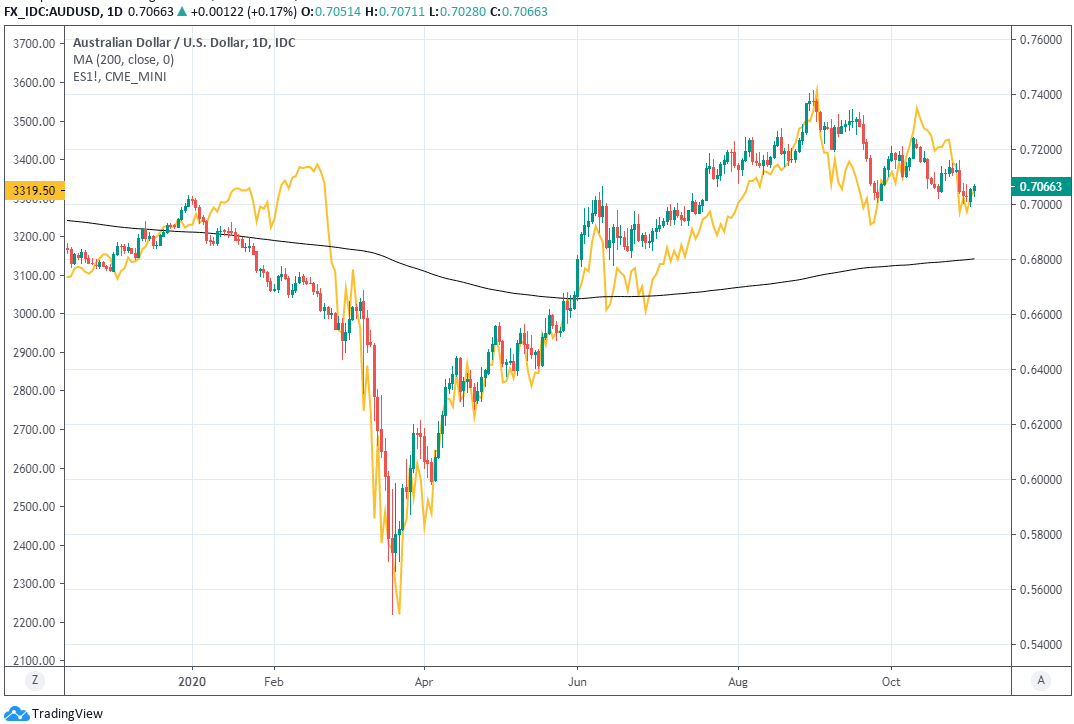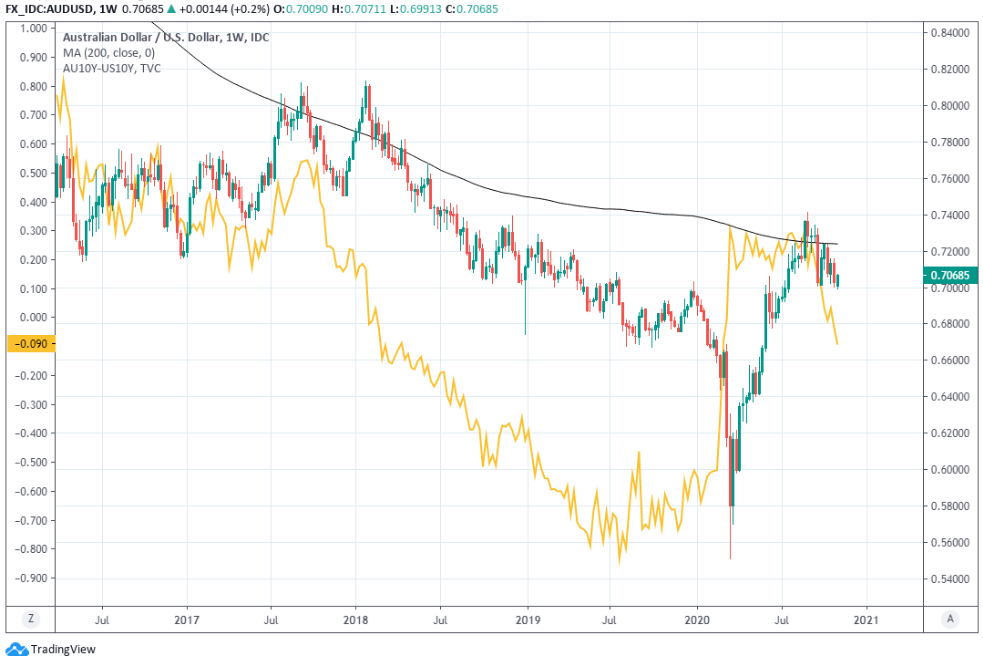Australian Dollar in Crosshairs as RBA Calls Time On Rally, but Election Dominates Short-term
- Written by: James Skinner
- AUD outperforms despite RBA warning, rate cut, QE expansion.
- RBA to intervene over AUD strength, but U.S. election dominates.
- USD key to short-term outlook but AUD weakness lurks further out.

Image © ArchivesACT, Reproduced under CC Licensing, Editorial, Non-Commercial
- GBP/AUD spot rate at time of writing: 1.8247
- Bank transfer rate (indicative guide): 1.7607-1.7735
- FX specialist providers (indicative guide): 1.7972-1.8082
- More information on FX specialist rates here
The Australian Dollar overlooked aggressive policy easing at the Reserve Bank of Australia (RBA) and an explicit threat of intervention in the currency market that is expected to be a burden for the Aussie in the months ahead, although the U.S. presidential election dominates the agenda this week.
Aussie Dollars were bought amid a widespread rally for risk assets ahead of voting in a U.S. election that will be pivotal to the global markets for at least the next four years, although some observers have suggested this resilience may not last for long in light of the RBA's new policy stance.
"The RBA expects the exchange rate to play a role in assisting the recovery and meets with our long-held view that the A$ is headed below 0.70 near term. However, with the backdrop of the US Presidential election outcome in the hours ahead, that move may have to wait," says Robert Rennie, head of market strategy at Westpac. "Technically, the A$ remains in a clear downtrend and would need to close above 0.7080/ 0.7120 to reverse that trend."
Governor Philip Lowe followed in the footsteps of the Reserve Bank of New Zealand when he said the RBA would intervene directly in the market under certain circumstances, almost echoing the RBNZ's threat to carry out foreign asset purchases that would inevitably result in large sales of Kiwi Dollars.
Both central banks have grown concerned about the impact that rising exchange rates will have on the inflation outlook over the coming years, given the two antipodean currencies had rallied more than 30% against the U.S. Dollar between March and early September.
Source: Westpac.
Unlike the RBNZ however, the RBA remains averse to the idea of a negative cash rate and reiterated that opposition on Tuesday, but bolder and more extensive language on the exchange rate could indicate an intention to lean more heavily into Australian Dollar rallies in the months ahead.
The warning came as the U.S. Dollar sold off ahead of the election and with the market looking to see a 'clean sweep' by the Democratic Party drag the U.S. Dollar down to new multi-year lows in the months head, providing a further lift to riskier currencies like the Aussie.
"We still expect the Australian dollar to strengthen gradually in the year ahead (click here) based on the assumption that the global economy will continue to recover led by China. That assumption though is currently under threat by the ongoing spread of COVID," says Lee Hardman, a currency analyst at MUFG.
As expected the bank cut its cash rate and three-year yield target to 0.10% on before expanding as well as recalibrating its quantitative easing programme so that an increased arsenal is concentrated on a segment of the maturity spectrum where high yields have proven to be a draw for international investors in recent months.
"These higher bond yields have added to the attractiveness of Australian dollar assets and this has put some upward pressure on the exchange rate," says Governor Philip Lowe in a statement. "We will continue to closely monitor the economic situation and the impact of our purchases on market functioning. If we need to do more, we can and we will. The RBA also has a range of tools to support the proper functioning of markets and address market dysfunction were that to occur. These tools include further liquidity provision, asset purchases and transactions in the foreign exchange market."
Above: AUD/USD rate shown at daily intervals alongside S&P 500 index futures (gap) (yellow line, left axis).
The RBA will buy A$100bn of state and federal government bonds over the next six months, an amount that is on the larger end of economist expectations and a duration that's at the shorter-end, with the newly created Aussie Dollars used to buy five-to-ten year government bonds.
"The Reserve Bank is committed to doing what it can to support the creation of jobs. Encouragingly, the recent economic data have been a bit better than expected and the near-term outlook is better than it was three months ago. Even so, the recovery is still expected to be bumpy and drawn out," Lowe said.
Lower yields could further drive the Australia-U.S. bond yield differential further below zero, potentially heralding further declines for the AUS/USD rate ahead, although the Aussie remained supported above 0.70 on Tuesday after having taken the RBA's rhetoric in its stride.
But for the time being at least major currencies will take their cues from investor sentiment, which is itself subject to the outcome of the U.S. election, which may not be known for certain for up to a week after the vote.
"AUD/USD can dip below 0.70 ahead of the US election today. How far it falls, and how long it stays below 0.70, will depend largely on the USD’s reaction to the election," says Joseph Capurso, a strategist at Commonwealth Bank of Australia. "The election result is very uncertain despite former Vice President Biden’s large lead in the national polls. The uncertainty about the outcome of the election and the risk of an inconclusive result on the day can lift currency volatility. JPY is likely to outperform GBP and EUR in the near term. The USD can firm further beyond Election Day if the result is contested. We consider the results of at least some swing states will be contested."
Above: AUD/USD rate shown at weekly intervals alongside 10-year AU-US bond yield spread (gap) (yellow line, left axis).
Financial markets have priced-in a blue wave scenario where the Democratic Party wins both houses of Congress and the White House, which many expect to lift stock markets and positively correlated currencies like the Aussie.
CBA says investors may be underappreciating the risk of a narrow and contested outcome that leads to a weeks long legal process. Investors have also given short-shrift to the idea of a surprise victory by the President Donal Trump, which is a recipe for volatility and strength in the U.S. Dollar if Trump is re-elected.
Voting begins in the European afternoon and continues into Wednesday, when results will begin to trickle in. Meanwhile, the technical backdrop on the charts has turned from bearish to almost neutral, indicating possible consolidation ahead, after AUD/USD held above 0.70 in last week's sell-off.
"AUD/USD’s lack of a close below the .7006 support coupled with a divergence of the daily RSI points to the idea that downside momentum has exhausted. We would allow for near term rebound and will opt to cover our short positions for now," says Karen Jones, head of technical analysis for currencies, commodities and bonds at Commerzbank. "The downtrend at .7137 maintains a negative bias and we are unable to rule out a slide to .6964, the 23.6% Fibonacci retracement. There is scope for this to extend towards the 200 day ma, the February high and mid-June low at .6803/774 which, if seen, is expected to hold the downside."







